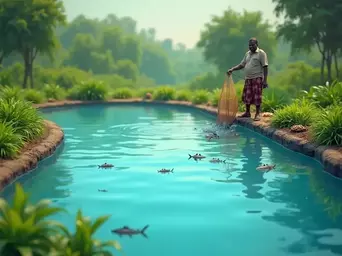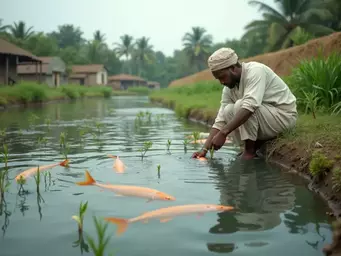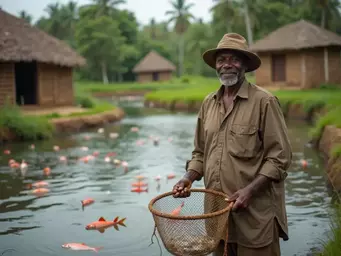Current Production & Species
200,000 metric tons annually.
Tilapia is the most cultivated species, Catfish is gaining momentum.
Unlock strategic insights and practical guidance for your aquaculture venture. Join our community of thriving fish farmers!
Posted on: 2025-10-01
By: Kwame Adom
As the demand for fish continues to rise, Ghana's aquaculture sector presents a wealth of opportunities for aspiring farmers. Are you ready to dive into this promising industry? Let’s explore the key insights that will empower your fish farming journey and set you up for success!
An overview of the aquaculture industry's current production, leading species, and critical factors influencing profitability and sustainability. To ensure your venture is well-structured from the start, consider crafting a comprehensive fish farming plan.
200,000 metric tons annually.
Tilapia is the most cultivated species, Catfish is gaining momentum.
Welcome to the thriving world of fish farming in Ghana! As someone who has immersed himself in aquaculture for over a decade, I’ve seen firsthand how this industry has evolved. The aquaculture industry in Ghana has become a vital part of our economy, providing not only food security but also numerous job opportunities. Let’s dive into what makes this sector so promising and how you can get involved!
Ghana's fish farming landscape is diverse, with an increasing number of entrepreneurs entering the market. These budding farmers are harnessing modern practices to enhance production, making it an exciting time for aquaculture enthusiasts. Are you considering starting your own fish farm? Understanding the current landscape will equip you with the knowledge needed to succeed.
The aquaculture industry in Ghana is on the rise, with fish production steadily increasing to meet the growing demand. As of now, the country produces a variety of fish species, with tilapia and catfish leading the charge. According to recent reports, Ghana is working towards self-sufficiency in fish production, which means there’s a lucrative opportunity for fish farmers!
With these statistics in mind, it's clear that the industry is poised for growth. If you’re ready to contribute to this sector, now is the perfect time to explore your options and make a splash!
As we look at trends shaping the profitability of fish farming in Ghana, a few stand out. The shift toward sustainable practices is significant, as more consumers demand ethically sourced fish. Additionally, technological advancements in farming techniques and feed management are improving yields and reducing costs. Are you up to date with these changes? They could greatly influence your profitability! Understanding fish market trends in Africa is key to staying competitive.
Staying informed about these trends will help you make strategic decisions that enhance your fish farming venture's success!
The Ghanaian government is actively supporting the aquaculture sector through various initiatives and regulations. This support includes funding for training programs, access to resources, and regulatory frameworks designed to ensure sustainable practices. Understanding these regulations is crucial for any aspiring fish farmer.
By leveraging government support, you can position yourself for success in this growing industry. Remember, there’s a whole network out there ready to assist you in your fish farming journey!
Did you know? Implementing integrated aquaculture can significantly enhance your operational efficiency. By combining fish farming with crop production, you can utilize fish waste as fertilizer, creating a sustainable cycle that benefits both your fish and crops. This practice not only reduces waste but also lowers input costs, increasing your overall profitability!
As we explore the dynamic world of fish farming, it's essential to consider sustainability practices that benefit both the environment and your bottom line. Implementing sustainable techniques not only helps in conserving resources but also enhances your farm's reputation among consumers who are increasingly eco-conscious. Here are some key environmental management techniques that can elevate your fish farming venture.
Effective environmental management is a cornerstone of sustainable fish farming. When it comes to fish farming in Ghana, employing the right techniques can lead to both better yields and a healthier ecosystem. Here are a few strategies worth considering:
By adopting these techniques, you'll not only enhance productivity but also contribute positively to the local ecosystem, ensuring long-term sustainability for your operations.
Sustainable fish farming isn't just about environmental responsibility; it's also a savvy business move. When you consider the benefits, you'll realize that integrating sustainability into your practices can lead to impressive profitability. Here's how:
By focusing on sustainability, you're not just protecting the environment; you're also positioning your business for long-term success in a competitive market.
Climate change poses significant challenges to fish farming, and adapting your practices is crucial for survival. As someone who has seen the impacts firsthand, I can assure you that being proactive is essential. Here are some strategies to consider for climate resilience:
Implementing these strategies will not only help safeguard your farm against the effects of climate change but also enhance your resilience in an uncertain future.
Once you've established sustainable practices in your fish farming business, the next step is ensuring that your products reach the market effectively. Crafting a solid marketing and distribution strategy is crucial for success. Let’s dive into some valuable techniques to enhance your market presence!
Adding value to your fish products can significantly increase your profits. It's not just about selling whole fish; it's about transforming your offering to meet consumer demands. Here are some value addition techniques to explore:
By incorporating these value addition techniques, you're not just increasing your profit margins; you're also enhancing customer satisfaction!
Developing a strong market strategy is essential for ensuring that your products reach the right customers. Here are the fundamental steps I recommend:
By focusing on these strategies, you'll create a robust marketing plan that boosts your brand recognition and sales.
As you refine your market strategy, consider both local demand and export opportunities. Ghana has a growing market for fish, and expanding your reach can significantly impact your profits. Here are some insights:
Exploring both local and export opportunities will enhance your market reach, leading to greater profitability for your fish farming business.
As we wrap up this section, let’s reflect on the essential takeaways that can empower your fish farming journey.
For those just starting, it's crucial to grasp the foundational elements of successful fish farming. Here are some strategic takeaways:
By keeping these takeaways in mind, you can set yourself on a path toward success in fish farming!
The future of fish farming in Ghana is promising, and encouraging investments in this sector will not only benefit farmers but also contribute to the local economy. Here’s how we can work together towards this goal:
By advocating for investments, we can help catalyze growth in Ghana's aquaculture, ensuring a bright future for all involved in the industry.
A1: Tilapia is the most cultivated species in Ghana, known for its fast growth and high market demand. Catfish farming is also rapidly gaining popularity due to its adaptability and flavor.
A2: Ghana's aquaculture industry produces around 200,000 metric tons of fish annually, with efforts geared towards achieving self-sufficiency in fish production.
A3: Sustainable practices are crucial as they lead to cost savings (e.g., efficient feed management), meet increasing consumer demand for ethically sourced fish, and ensure compliance with environmental regulations, all of which enhance long-term profitability.
A4: The Ghanaian government offers various forms of support, including grants, subsidies, access to training programs for skill development, and regulatory frameworks designed to promote sustainable aquaculture practices.
A5: Key techniques include integrated aquaculture (using fish waste as fertilizer for crops), water recycling systems like biofiltration to conserve resources and minimize pollution, and the cultivation of native fish species for better survival rates.
A6: Adaptation strategies include diversifying cultivated fish species to reduce risk, utilizing technology to monitor water temperature and quality for quick adjustments, and establishing buffer zones to protect farms from floods and soil erosion.
A7: Value addition techniques include filleting and proper packaging, smoking and drying fish to create premium products, and offering ready-to-cook options like pre-marinated fish or meal kits to cater to consumer convenience.
A8: A strong market strategy is essential. It involves identifying your target market, creating partnerships with local restaurants and supermarkets, and utilizing online platforms to market products, all of which boost brand recognition and sales.
Here is a quick recap of the important points discussed in the article:



 As the demand for fish continues to rise, Ghana's aquaculture sector presents a wealth of opportunit
As the demand for fish continues to rise, Ghana's aquaculture sector presents a wealth of opportunit
 Did you know that small-scale fish farming is poised to transform local economies in Nigeria? As dem
Did you know that small-scale fish farming is poised to transform local economies in Nigeria? As dem
 In the world of aquaculture, success stories abound, but what are the lessons that can drive aspirin
In the world of aquaculture, success stories abound, but what are the lessons that can drive aspirin